The Omnitruncated 5-cell
The omnitruncated 5-cell is a uniform polychoron consisting of 30 cells (10 truncated octahedra, 20 hexagonal prisms), 150 polygons (90 squares, 60 hexagons), 240 edges, and 120 vertices.
Structure
The following image shows the parallel projection of the omnitruncated 5-cell into 3D:
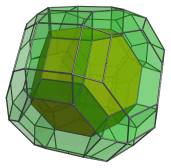
The central yellow truncated octahedron is the nearest cell to the 4D viewpoint. Four of its hexagonal faces are joined to 4 other truncated octahedra, as shown in the next images:
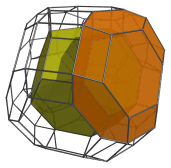
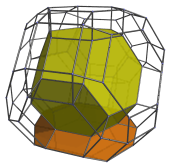
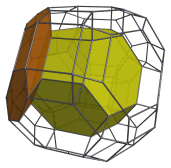
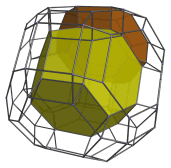
The other 4 hexagonal faces of the nearest cell are joined to 4 hexagonal prisms, as shown in the following image:
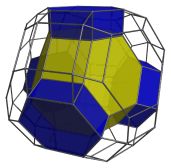
The 6 square faces of the nearest cell are joined to 6 hexagonal prisms straddling these 4 hexagonal prisms. All 10 hexagonal prisms are shown in the next image:
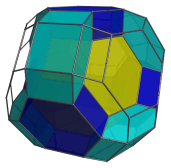
The 5 truncated octahedra and 10 hexagonal prisms we have seen so far are the cells lying in the “northern hemisphere” of the omnitruncated 5-cell. On the opposite side of the omnitruncated 5-cell are another 5 truncated octahedra and 10 hexagonal prisms, laid out in dual orientation to these cells. These are shown in the following images.
The antipodal truncated octahedron (the “south pole” cell, shown here in brown) and its surrounding 4 truncated octahedra (yellow):
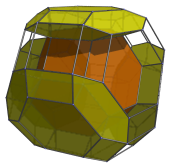
And the 10 hexagonal prisms surrounding the south pole cell:
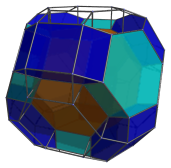
Perspective Projection
The following image shows the perspective projection of the omnitruncated 5-cell into 3D:
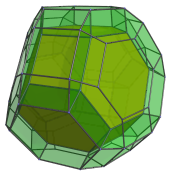
This projection is almost the same as the parallel projection, except that the foreshortening of the truncated octahedra surrounding the nearest cell is more pronounced.
Coordinates
The Cartesian coordinates for the omnitruncated 5-cell, centered on the origin and having edge length 2, are:
|
|
Simpler coordinates can be obtained in 5D as all permutations of coordinates of:
- (0, √2, 2√2, 3√2, 4√2)
The 4D coordinates are derived by projecting these 5D coordinates back into 4D using a symmetric projection.




